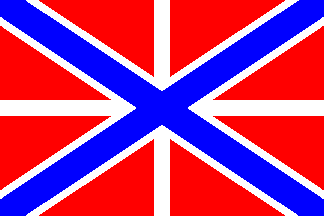
Last modified: 2007-06-09 by antónio martins
Keywords: navy | jack | ensign | andreevskiĭ | saint andrew | saltire (blue) | cross (white) | surrender | defeat |
Links: FOTW homepage |
search |
disclaimer and copyright |
write us |
mirrors
Russian Navy website,
reported by Pascal Vagnat, 16 Dec 1998
The Russian Navy website is not a good source. We know about lot of
mistakes at this website.
Victor Lomantsov, 20 Jan 2001

First adopted in 1712.
António Martins, 25 Oct 1999
This flag is called in russian
"андреевский"
(read "ahndrehyevskeey"), which means "[St.]
Andrew’s", refering to the saltire
motive.
António Martins, 11 Jun 2000
It was precisely on ships of the Russian Black Sea Fleet that
this flag was hoisted for the first time three hundred years ago
by the order of Peter the Great. The history of the Russian navy
knows not a single case when this flag was lowered as a sign of
surrender to the enemy.
Lev Ryabchikov (ITAR-TASS), 11 Dec 1999
A cute bit of phraseology! One can always twist words to make
even the greatest catastrophe sound glorious and pleasant.
In 1904-05 the Japanese destroyed most of Russia’s Pacific fleet.
The Baltic fleet then circumnavigated the globe to meet the
Japanese — only to meet the same fate. Many ships did indeed go
down with St. Andrew’s flag still flying. After that disaster, Russia
began a massive rebuilding programme.
Todd Mills, 13 Dec 1999
With all due respect to the Russian Navy, this claim strikes me as
unlikely since the Japanese Navy took several Russian warships as prizes
at the Battle of Tsushima, some of which were repaired and
recommissioned in the IJN, e.g. the
Okinoshima, ex-General Admiral Graf Apaaksin.
Tom Gregg, 13 Dec 1999
Even apart from the Tsushima debacle, I’m skeptical of this claim.
There were periods in the Napoleonic wars, if I recall correctly, when
Russia was allied with France. I’d bet that at least once in
that period a Russian man-of-war struck to a British vessel somewhere
in the world. And no surrenders during the Crimean War? World War I?
Really hard to believe.
Joe McMillan, 13 Dec 1999
I checked Fred T. Jane’s 1904 book, The Imperial Russian Navy, just to verify my hunch that it couldn’t be true. In his historical chapters, Jane includes examples of Russian ships surrendering to Swedish, Austrian, and British ships. This includes specifically the statements that the 74-gun ship of the line Vladimir “struck” to the Swedes at Gotland in 1714 and the Svlod to HMS Centaur in 1808. In addition, although Jane doesn’t specifically refer to striking of colors, Admiral Senyavin surrendered his entire fleet to the Royal Navy in the Tagus estuary in Portugal in August 1808. Since Jane was writing before the Russo-Japanese War, this does not include the Tsushima debacle.
The current Andreyevsky flag was introduced in 1712 and remained the ensign of the Russian Navy until 1917. There’s a remote chance, I suppose, that in each case mentioned above (and the other surrenders of Russian vessels) it was some other flag that was struck. Many flags were used at varying periods up to 1865, so it may be that there’s a bit of sophistry at play in the claim that the Andreyevsky flag has never been lowered in surrender. But I’d say the burden of proof is on the Russian Navy, and even if that’s their rationale it would be a pretty flimsy case.
Joe McMillan, 16 Dec 1999

First adopted in 1700.
António Martins, 25 Oct 1999
Anything below this line was not added by the editor of this page.